The Dell XPS 13 (9300) Review: Return of the King
by Brett Howse on July 16, 2020 10:00 AM ESTDisplay Analysis
Dell’s move back to 16:10 on their XPS laptop display panels is likely a welcome change for almost all prospective buyers. The PC industry aggressively moved to 16:9 with the rise of HD televisions, and while the 16:9 aspect ratio is still the default for most PC gaming and media consumption, most productivity tasks will enjoy the slightly taller display. Going to 16:10 instead of 3:2 like we have seen on Microsoft’s Surface lineup is also a nice compromise between productivity and consumption.
Dell is offering both 1920x1200 and 3840x2400 display offerings, which is in-line with what they’ve been doing with the XPS 13 lineup since at least 2015. For 2020 though, there is an optional touch digitizer on the lower resolution display, whereas in the past Dell only included touch with the higher-resolution panel. Both displays offer Dolby Vision processing and Eyesafe technology to reduce blue light transmission.
The 1920x1200 panel is a standard sRGB display, rated at 500 nits of brightness. Meanwhile the 3840x2400 panel has a much wider color gamut – offering 90% of the P3 color space – and is HDR 400 certified as well.
Dell sampled us the lower-resolution panel for review, but as with any Windows-based notebook with wider than sRGB gamut coverage, it is still a 'buyer beware' situation. Windows 10 does not offer the best color management system, and since almost all content and programs are designed around sRGB, if you opt for the wider-gamut display colors will be blown out unless you are using an application that specifically supports color management. For most people, the sRGB panel is the better option, not only because the 1920x1200 13.4-inch display still provides a reasonable 170 pixels-per-inch and much better battery life, but also because Windows still deals with wide-gamut and HDR poorly.
One area where Dell needs to be commended though is in their use of anti-glare coatings on their XPS displays. This has been one area that no PC manufacturer has really put much effort in, but Dell offers a 0.65% reflectivity rating on their coating, and it makes a big difference in day-to-day usage, especially in a bright room or outdoors.
To see how the XPS 13 display performs, it was tested using the Portrait Displays CalMAN software suite, using a custom workflow. Brightness and contrast were measured with the X-Rite i1Display Pro colorimeter, and color accuracy measurements were done with the X-Rite i1Pro2 spectrophotometer.
Brightness and Contrast
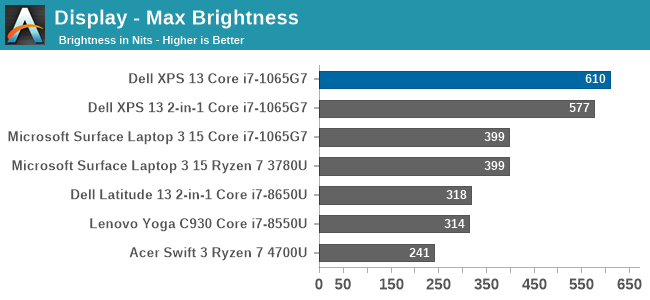
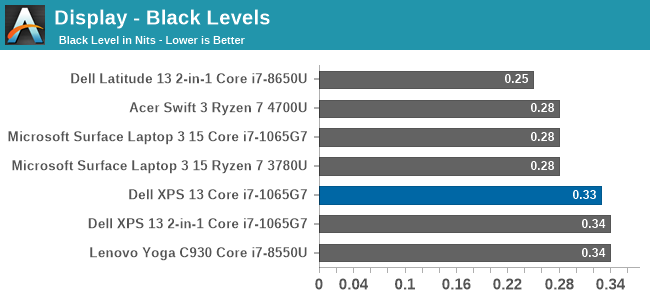
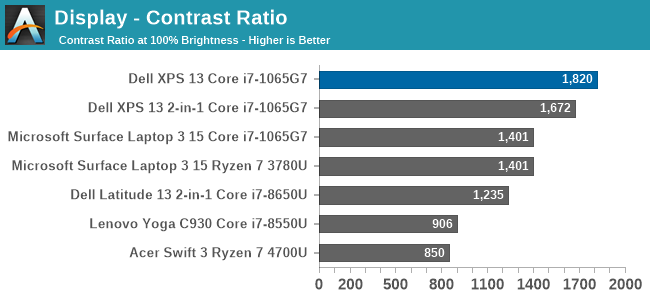
Despite the 500-nit rating, the XPS 13 managed to achieve a very impressive 610 nits of brightness. Coupled with the excellent anti-reflective coatings, the XPS 13 is easily one of the best notebooks for any bright location. The contrast ration of over 1800:1 was also top-notch.
Grayscale
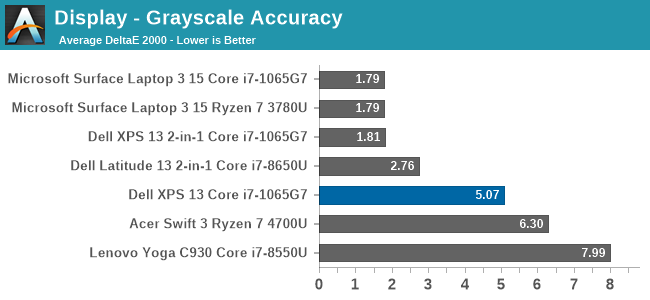
Despite the XPS 13 including an ICC profile, the review unit offered very poor grayscale performance, which was a disappointment after the XPS 13 2-in-1 we reviewed in November had such great results. Dell is likely using a batch-calibration process, rather than tuning each panel individually, which is a shame.
Gamut
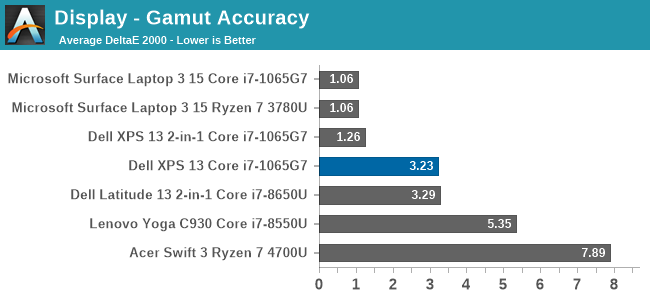
Grayscale aside, the color gamut results show a much better outcome, with really only Cyan having much in the way of color error. The display nicely hits sRGB primary and secondary color points, although does pull a bit to the green end, especially on Cyan.
Saturation
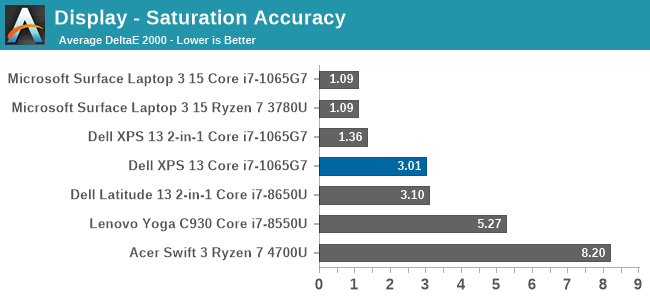
Gamut tests the sRGB color space at the 100% levels, but for the saturation test each primary and secondary color is tested in 4-bit steps from 0% to 100%. Really, other than the Cyan errors, the XPS 13’s color accuracy on these sweeps is quite good, just missing the 3.0 DeltaE threshold.
Gretag Macbeth

The Gretag Macbeth colorchecker tests many colors, not just the primary and secondary colors, and includes the important skin tones. To be considered accurate, all of the color tests on the DeltaE 2000 scale should be under the yellow line, and for the most part that is the case. The grayscales and the most impacted, which isn’t surprising with how inaccurate the grayscale was on this unit, with only a few colors over the 3.0 error level.
Colorchecker
The colorcheck swatch provides a relative look at how the display performs. The colors on the bottom half of the swatch are the targeted colors, and the top half is what the XPS 13 was able to provide. This is a relative result, because any error in your own display would impact this swatch.
For the most part, the color accuracy of the XPS 13 is very good, with mostly only grayscale errors. The bad news is that Dell did include an ICC profile to address this, but it had little to no impact on the grayscale. Meanwhile the good news is that since most of the errors are grayscale, if you owned your own calibration tools, the XPS 13 could be adjusted to give a reasonable result. But as a premium device, it would be nice to see Dell extend the calibration to every panel.
















224 Comments
View All Comments
sonny73n - Friday, July 17, 2020 - link
Haha... Dell XPS i7 $1400 gets beat up by Acer 4700U $650. Lovely!Based on some comments here, Intel fanboys are a bunch of sore losers.
Walkeer - Thursday, July 16, 2020 - link
a king...with intel...in 2020 XDikjadoon - Thursday, July 16, 2020 - link
I really hope manufacturers copy Dell's strong improvements here: no silly keyboard gimmicks or bloatware (looking at you, *****ing HP), improve the screen contrast, glare, and ratio (you gotta stare it all day), and nail battery life. With a near 16-hour real-world battery life, it absolutely dissuades ARM transitions purely for efficiency.But, while I love Dell's improvements, a few hard-to-swallow regressions here:
-- no type-A port. That's just frustrating. Are we *really* in a type-C-only world? No. And Dell knows that. Why is a "productivity" device (16:10 panel) handicapped? Did we need it thinner? Where the hell are all the PCH's USB / PCIe bandwidth going? Into the ... charge port? We should have 4X type-C ports these days.
-- soldered SSD. An absolutely groundless regression. Goodbye to a last-chance backup if the motherboard dies. And don't even think about out-of-warranty replacements.
-- toasty, toasty, toasty bottoms. 42 W PL2, even with GORE, is absolutely "crazy", as Anandtech points out. Likewise, Notebookcheck notched a nearly 30C idle bottom panel in a 20C room: the heat just exudes out even at idle. Add in a heavy load and you're at a toasty 46C in the back bottom (https://www.notebookcheck.net/Dell-XPS-13-9300-Cor...
And, it should be noted: Dell still sells the older Comet Lake-U models, so buyer beware which "XPS 13" you click on. The product names are identical and both use "10th gen" CPUs.
TheinsanegamerN - Thursday, July 16, 2020 - link
High heat, lack of useful ports and soldered storage make this a worthless device.sonny73n - Saturday, July 18, 2020 - link
Buyers don’t have to beware. Just use it for a couple weeks then return. I went to dell website to check the price and specs of the model AT reviews. They have everything messy. No filter and no year of release for all the laptops they’re selling. Only “for home” and “for work”. wtf? I can’t buy a “work” laptop just to watch youtube at home? How about a laptop for both home and work?I used to prefer dell products especially monitors but since they became intel’s lap dog to monopolize the market, I put them on my “do not buy” list. Overpriced dells are for idiots.
stanleyipkiss - Thursday, July 16, 2020 - link
It WOULD be a solid laptop (the perfect ultrabook even) -- if they had included at least ONE USB A port.sonny73n - Friday, July 17, 2020 - link
NOT when it costs $1400.Sharma_Ji - Thursday, July 16, 2020 - link
Qualcomm based atheros wireless modules were so good, I don't believe how killer ones are so bad, that intel acquired killer, sad that Qualcomm based modules will no longer will be available.invinciblegod - Thursday, July 16, 2020 - link
I don't know, are Qualcomm's wireless modules that good for Windows? I've had many problems in enterprises where Qualcomm's wifi was always unstable compared to Intel's. Though admittedly, at home I never had a problem.shadowjk - Sunday, July 19, 2020 - link
Qualcomm based Killer WiFi is borderline unusable. If you can get the hardware running on the regular drivers from Qualcomm it gets tolerable.